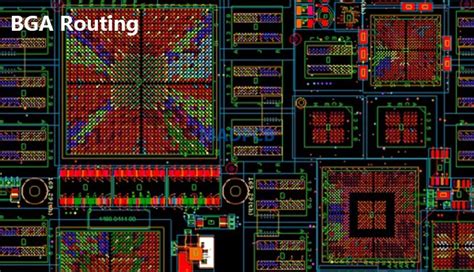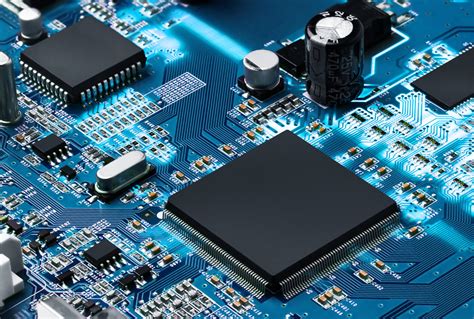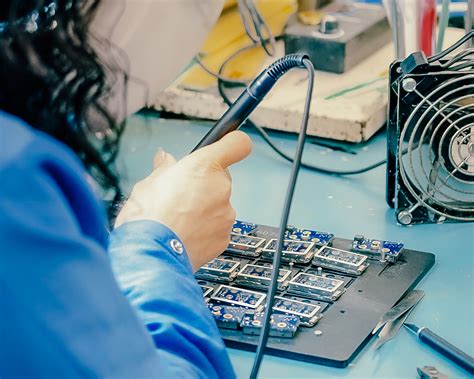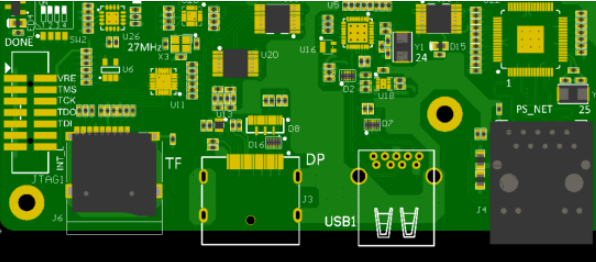Revolutionizing Manufacturing: The Rise of Automated Circuit Board Assembly
Key Takeaways
The advent of automated circuit board assembly (pcba) has ushered in a new era in manufacturing, addressing both the complexities of production and the increasing demand for electronic devices. Through the integration of robotics and sophisticated artificial intelligence systems, companies can now streamline their pcb assembly processes, leading to a remarkable reduction in human error. This efficiency not only enhances productivity but also ensures that the final products adhere to a high-quality standard that is essential in the competitive electronics market. As businesses strive to meet global demand, the scalability offered by automated solutions is becoming indispensable. However, this transition is not without challenges; the industry must navigate issues such as workforce adaptation and initial investment costs. Despite these hurdles, the future of automated circuit board assembly looks promising, with significant potential to revolutionize production practices and solidify its role within the broader electronics sector. The ongoing evolution of this technology will likely redefine how manufacturing processes are envisioned and executed, making it a critical area of focus for stakeholders in the industry.
Introduction to Automated Circuit Board Assembly
The field of pcb assembly has undergone significant transformation with the advent of automation technologies. Automated Circuit Board Assembly (ACBA) refers to the use of advanced machinery and systems to manufacture pcba efficiently and accurately. This process involves various stages, including component placement, soldering, and testing, all executed with minimal human intervention. The integration of robotics has been pivotal in enhancing production speeds and precision, allowing manufacturers to produce high-quality pcba at unprecedented rates. Moreover, the incorporation of artificial intelligence in these automated systems has enabled smart decision-making processes that adapt in real-time to optimize assembly operations. This not only reduces the risk of errors but also minimizes material waste, further contributing to sustainable manufacturing practices. As the electronics industry continues to expand with rising demand for innovative products, pcb assembly automation presents a scalable solution that can efficiently meet market needs while fostering advancements in manufacturing techniques. Understanding these foundational aspects of automated circuit board assembly is essential for appreciating its transformative power in modern manufacturing landscapes.
The Role of Robotics in Circuit Board Production
The integration of robotics in the production of pcb assembly has marked a significant shift in how manufacturers approach the construction and assembly of electronic components. Utilizing highly sophisticated robotic systems, companies are now able to automate various stages of pcba production, which includes soldering, component placement, and inspection. These advancements not only enhance precision but also contribute to a reduction in manufacturing errors that can lead to costly defects. The ability to program robots for repetitive tasks allows for a consistent production environment where speed and accuracy are prioritized over manual labor. Furthermore, the flexibility offered by robotic systems enables manufacturers to quickly adapt to changing designs and specifications, catering to a dynamic market that demands higher efficiency. As the trend towards automation continues, the role of robotics is set to evolve further, potentially allowing for real-time adjustments during the pcb assembly process. This adaptability is crucial as it aligns with the growing complexities associated with modern electronic devices. Overall, embracing robotics within circuit board production is not merely about cutting costs; it is about driving innovation and maintaining competitiveness in an ever-evolving industry landscape.
Advancements in Artificial Intelligence for Manufacturing
The integration of artificial intelligence in pcb assembly processes has revolutionized how manufacturers approach production. By leveraging advanced algorithms and machine learning techniques, companies are now able to optimize their pcba lines like never before. For instance, AI-driven predictive maintenance systems can anticipate equipment failures before they occur, thereby minimizing downtime and ensuring a smooth manufacturing flow. Moreover, AI technologies enable real-time data analysis which can refine operating parameters and increase overall efficiency. This not only leads to fewer defects in the final product but also enhances the consistency of the production process. As automation becomes more sophisticated, it empowers manufacturers to implement smarter quality control measures throughout the pcb assembly process. With these advancements, businesses can adapt quickly to changing market demands while maintaining high standards of productivity and quality. Ultimately, these innovations signify a significant leap forward in the evolution of manufacturing practices related to electronic components, highlighting the indispensable role that automation will play in shaping the future of the industry.
Benefits of Automation in Reducing Errors and Enhancing Efficiency
In the realm of pcb assembly, automation presents a robust solution to minimizing errors and maximizing efficiency. The integration of advanced technologies, such as robotics and artificial intelligence, into pcba processes significantly streamlines production lines. For instance, automated systems are capable of performing repetitive tasks with high precision, drastically reducing the chances of human error that can lead to costly defects.
Moreover, the consistently reliable performance of automated machinery leads to enhanced quality control in pcb assembly, ensuring that each circuit board meets stringent industry standards. This reliability is critical in a market where electronic devices are increasingly complex and require flawless assembly for optimal functionality.
The following table illustrates some key advantages of automation in pcba:
| Benefit | Description |
|---|---|
| Error Reduction | Automation minimizes human error through precise machinery operation. |
| Increased Production Speed | Automated systems can operate continuously, boosting output rates. |
| Improved Consistency | Standardized processes lead to uniform quality across production runs. |
| Scalability | Automated systems can be scaled up easily to meet rising demand. |
“Investing in automation is not just about technology; it’s about redefining efficiency and quality standards in manufacturing.”
By adopting automated solutions for pcb assembly, manufacturers can address the challenges posed by global demand for electronics while ensuring that the production processes remain both reliable and efficient. As this technology continues to evolve, it holds great promise for further enhancements in the electronics industry, paving the way for innovations that redefine how circuit boards are produced.
Meeting Global Demand: Scalability of Automated Solutions
As the electronics industry continues to flourish, the need for efficient and reliable pcb assembly processes becomes increasingly crucial. Automated circuit board assembly technologies are rising to the occasion, presenting scalable solutions capable of meeting the soaring global demand for products such as smartphones, computers, and other electronic devices. The flexibility inherent in these automated systems allows manufacturers to easily scale operations up or down, ensuring that production levels align with market fluctuations without compromising on quality. With advancements in both robotics and pcba methodologies, companies can efficiently manage high-volume production runs while simultaneously addressing complex configurations and customized requirements. This capacity for scalability not only reduces lead times but also enhances overall operational efficiency, enabling manufacturers to deliver products faster to consumers. Furthermore, by incorporating automation into circuit board production lines, businesses can minimize human error—typically a significant risk factor in manual assembly processes—thereby further solidifying their production reliability and consistency. As market dynamics evolve and new technologies emerge, the adaptability of automated solutions will become a pivotal aspect in driving the growth of the electronics sector as a whole.
Challenges Facing the Adoption of Automated Technologies
While automated circuit board assembly (often referred to as pcba) presents numerous advantages for manufacturers, its adoption is not without challenges. One significant hurdle involves the initial investment cost associated with the required technology and infrastructure. The transition from traditional methods to automation necessitates a considerable financial commitment, which can be a deterrent for small to medium-sized enterprises. Furthermore, there are concerns regarding the technical expertise required to operate and maintain complex machinery and software systems that drive automated assembly lines. Companies may struggle to find or train personnel with the requisite skills in robotics and artificial intelligence to effectively oversee these operations.
Additionally, integration with existing production processes can prove challenging; organizations must ensure that their current systems can seamlessly collaborate with new automated technologies. Potential resistance from employees who fear job displacement or are apprehensive about working alongside machines also complicates the transition. Embedding a culture of innovation and change within an organization is essential for overcoming this resistance and facilitating a successful shift toward pcb assembly automation.
Finally, while there is significant interest in scalability, companies must navigate fluctuating market conditions that may affect their production needs. Developing flexible solutions that can easily adapt to varying demand cycles is crucial for those involved in pcba. By addressing these challenges head-on, manufacturers can better position themselves to leverage the full benefits of automated technologies in the evolving landscape of electronics production.
Future Prospects: The Evolution of Circuit Board Manufacturing
The future of pcb assembly and pcba processes looks increasingly promising as technology continues to advance. With the integration of automation, we expect a significant transformation in how circuit boards are produced. As companies strive to meet the soaring demand for electronics, these innovations provide a pathway to enhance production capacity without sacrificing quality. In the coming years, we may see more sophisticated robotics technologies and machine learning algorithms working in tandem to further minimize errors during the pcb assembly process. The real-time feedback from automated systems allows for immediate corrections, thereby increasing production accuracy and reducing waste. Furthermore, as industries adopt these high-tech solutions, we can anticipate a more considerable shift towards sustainable manufacturing practices, where resource efficiency becomes a standard practice in pcba operations. This evolution promises not only to sustain but potentially elevate the standards of quality and efficiency within the electronics sector, positioning companies well in an increasingly competitive global landscape. Such advancements will redefine traditional manufacturing models and establish new benchmarks for success in the years to come.
The Impact of Automation on the Electronics Industry
The integration of automated circuit board assembly into the electronics industry has fundamentally transformed traditional manufacturing practices. With the rise of pcb assembly technologies, manufacturers are experiencing unprecedented levels of efficiency and precision. The implementation of advanced robotics in pcba processes not only minimizes human error but also accelerates production timelines, allowing companies to keep pace with the ever-increasing demand for electronic devices. Furthermore, automated solutions have made it possible to scale production more effectively, addressing both regional and global market needs. However, while the benefits are substantial, challenges remain, including the need for skilled personnel to manage these sophisticated systems and the initial investment costs associated with transitioning to automation. As these hurdles are progressively overcome, it is clear that automation will play a pivotal role in advancing the future of circuit board manufacturing, solidifying its importance within the broader electronics industry landscape.
Conclusion
The emergence of automated circuit board assembly (PCBA) stands as a pivotal development in the manufacturing landscape, significantly influencing the production of electronic components. This revolution in pcb assembly integrates sophisticated robotics and intelligent systems to enhance operational efficiency and precision. With escalating global demand for electronics, automation not only meets scalability needs but also minimizes human error, ensuring consistent quality throughout the pcb assembly process. Despite facing challenges—such as initial investment costs and the need for specialized skills—these obstacles are increasingly being addressed through technological advancements and training initiatives. As industries adapt these automated solutions, the impact on the electronics sector will likely be profound, setting new standards for productivity and innovation in manufacturing. The future of circuit board production appears promising, with ongoing enhancements in automation presenting numerous opportunities for growth and efficiency.
FAQs
In recent years, automated circuit board assembly (or pcb assembly) has become a cornerstone in the evolution of electronic manufacturing. As an intricate process, pcba integrates multiple technologies, showcasing significant advancements in both robotics and artificial intelligence. One of the most prevalent questions surrounding this technological shift is: What are the primary advantages of using an automated approach for circuit board production? The benefits are manifold; error rates have notably decreased as machines take on tasks traditionally performed by humans, leading to enhanced quality control. Additionally, the speed of production has increased substantially, allowing manufacturers to meet soaring global demand for electronics efficiently.
Another common inquiry revolves around how automation impacts cost and scalability. The ability to scale operations quickly is a game-changer for companies that need to react swiftly to market fluctuations. This means that as demand rises, manufacturers can ramp up production without a hefty investment in labor costs. However, challenges still remain, such as the initial capital investment in automated systems and the need for ongoing training for staff to manage new technologies competently.
Understanding these dynamics is crucial for businesses aiming to navigate this transformative landscape. As such, continued discussion and exploration into these frequently asked questions will aid stakeholders in making informed decisions about integrating pcb assembly into their operations. For those looking to dive deeper into advanced automated solutions for circuit board production, please click here: Automated PCB Assembly Solutions.







